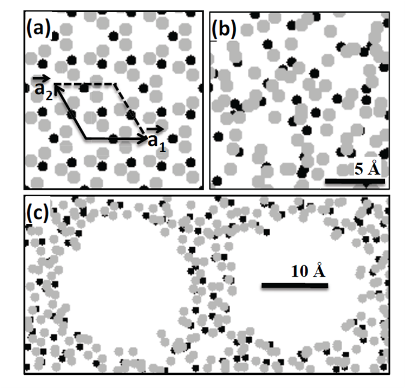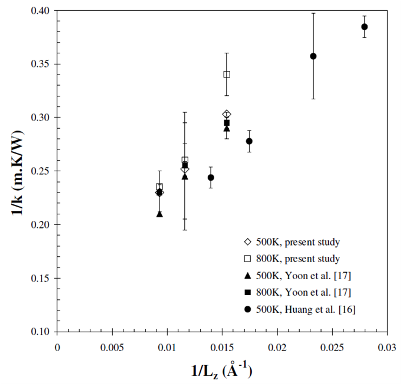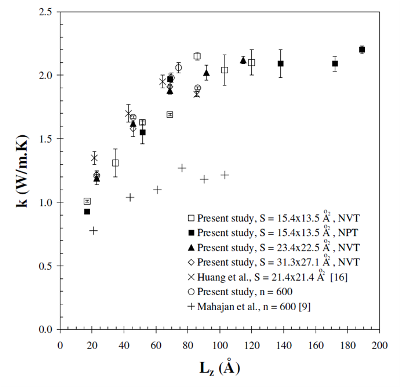Nanoporous amorphous silica is being considered as ultra-low-k dielectric interlayer materials for their low dielectric constant. In addition, nanoporous silica acts as a thermal insulator and may constitute a barrier to efficient heat removal. Nanoporous silica thin films have also been used for thermal insulation of infrared detectors and various MEMS devices. In these applications, knowledge of the thermal conductivity of nanoporous silica thin films is essential for the design and thermal management of devices.
This study aims to predict the thermal conductivity of nanoporous amorphous silica thin films using non-equilibrium MD simulations. Effect of cell length, spherical pore diameter, and porosity were investigated. Results are compared with (i) recent experimental measurements for highly ordered mesoporous silica thin films and (ii) predictions based on continuum theory of heat conduction in porous media.
 |
 |
Fig. 1. Simulation cell divided into 2N slices along the heat flux direction. Periodic boundary onditions were applied in all directions. |
Fig. 2. Structures of (a) a-quartz phase with the out-of-plane direction corresponding to the [0001] direction or c-axis, (b) amorphous silica phase, and (c) nanoporous amorphous silica phase with two spherical pores. |
 |
 |
| Fig. 3. Predicted values of 1/k as a function of 1/Lz for crystalline α-quartz at 500 and 800 K along with results reported in the literature. | Fig. 4. Predicted k of amorphous silica systems at 300 K as a function of Lz for various cross-sections generated using NVT and NPT ensembles along with results reported in the literature. |
Results and Discussion
 |
 |
Fig. 5. Predicted k at 300 K as a function of Lz for amorphous nanoporous silica systems of porosity fv = 25 ±2% with various values of cross-section S and pore diameter dp along with that of the corresponding dense amorphous silica systems. |
Fig. 6. Predicted keff/kc at 300 K as a function of porosity for amorphous nanoporous silica systems of 23.4x22.5x114.7 Å3 along with experimental data and predictions from commonly used effective medium approximations. |
Conclusion
The predicted thermal conductivity of nanoporous silica were independent of the cross-section of the simulation cell and of the ensemble used to generate the amorphous silica phase. The thermal conductivity was also independent of the system length Lz when the latter was larger than 11 nm, for both non-porous and nanoporous silica. The thermal conductivity of nanoporous silica was also found to be independent of pore diameter and depended only on porosity. It is worth noticing that the same results were observed experimentally for highly-ordered cubic and hexagonal mesoporous silica. Then, nanoporous silica can be treated as a continuous homogeneous medium with some effective thermal conductivity. The thermal conductivity predicted by MD simulations was in good agreement with the coherent potential model. On the other hand, predictions by finite element analysis based on continuum theory agreed with the well-known Maxwell Garnett model. Differences between MD simulation predictions and experimental data could possibly be attributed to the presence of "necks" connecting the pores in actual amorphous sol-gel mesoporous silica and ignored in the MD simulations.
References
T. Coquil, J. Fang, and L. Pilon, 2011. Molecular Dynamic Study of Thermal Conductivity of Amorphous Nanoporous Silica. International Journal of Heat and Mass Transfer, Vol. 54, pp. 4540–4548. doi:10.1016/j.ijheatmasstransfer.2011.06.024
T. Coquil, E. Richman, N. Hutchinson, S. Tolbert, and L. Pilon, 2009. Thermal Conductivity of Cubic and Hexagonal Mesoporous Silica Thin Films, Journal of Applied Physics, Vol. 106, no.3, 034910. Selected to appear in Virtual Journal of Nanoscale Science & Technology, Vol. 20, no.8, August 24, 2009. doi:10.1063/1.3182826